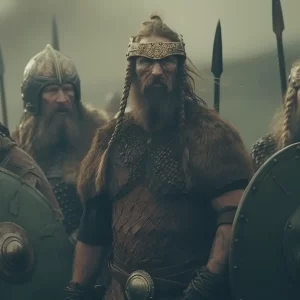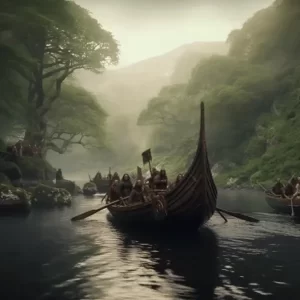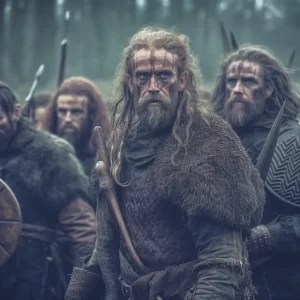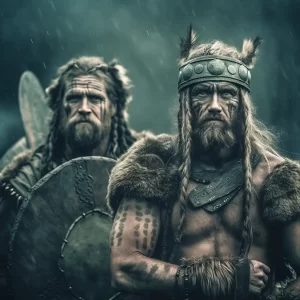You may or may not have heard of the Fir Bolg. I know I had not until recent years which is a shame. The story of these mysterious people and the other “tribes of Ireland” is a story that could rival that of the Greek Heroes.
Let’s find out more about the Fir Bolg and learn together exactly who these people were!
The Fir Bolg

Firbolg Mythology
They were an ancient and likely mythical group of people who were believed to have migrated to Ireland from mainland Europe around 1500 BCE. That is a whopping 3500 years ago!
The story of the Fir Bolg is told in the 11th century manuscript, known as the Book of Invasions. The Book of Invasions is itself supposedly based on older texts which no longer exist.
According to early Celtic Irish mythology, the FirBolg were one of the earliest groups or races to settle in Ireland. They are also one of the six tribes of Ireland who inhabited Ireland at various points through pre-historic times.
Their story has played an important role in the early history and mythology of the island of Ireland.
Arrival in Ireland
The arrival of the Fir Bolg in Ireland is a subject steeped in both history, myth, and legend. They are believed to have come to Ireland during the time period that we would now classify as the Bronze Age. This is a time when Ireland was still heavily forested and sparsely populated.

Did the Fir Bolg originally came from Greece and brought kingship to Ireland?
Historical evidence suggests that if they actually existed, they may have been a migratory people. They are theorised to have arrived in Ireland from the European continent.
Migration
At that time, there were waves of migration all across Europe and into Ireland. These waves varied from Neanderthals to early human hunter gatherers. Later, they were followed by waves of bronze age farmers. Eventually the Celts themselves arrived.
They are often thought of as a pre-Celtic people, while other scholars have suggested that they were of Celtic origin. The exact origins however remain a subject of debate among historians and archaeologists, as does their very existence.
According to Irish mythology and the Book of Invasions, they arrived in Ireland after a long journey across the sea. They are said to have landed at Inber Scéne, a location believed to be somewhere in the west of Ireland.
Upon their arrival, they were able to establish themselves as a powerful tribe amongst the other tribes in Ireland, conquering their land and building settlements. Eventually they were able to establish a strong presence throughout Ireland.

Firbolg Origins
The legends surrounding their arrival in Ireland are numerous and vary according to sources. Some suggest that they were driven from their homeland by a powerful enemy. Others describe them as wandering exiles searching for a new home. Still others claim that they were descendants of a powerful race of giants who once ruled over Ireland.
The most commonly shared origin story is that they were descended from a group of people who had been enslaved in Greece. They managed to escape slavery and eventually made their way to Ireland.
As such, some have made comparisons to the lost tribes of Israel, and other groups who were said to have escaped enslavement and reached a new promised land. The literal translation of their name is “men of bags” or “bag men”, but the origin of this name is also disputed.
Clan Life
The Fir Bolg were said to be a tribal people who were organized into several clans. Each clad had its own ruling chieftain, not unlike the Celtic culture that existed in Ireland during the early centuries AD.
They were described as being primarily farmers and craftsmen who lived in small, self-sufficient communities. Their society was hierarchical, with the ruling class having greater privileges and social status than those who came from lesser classes.
According to the myths, the Fir Bolg were skilled in metalworking, producing fine bronze objects and weapons. They were also said to have had a strong tradition of storytelling. This is potentially why many myths and legends are associated with their culture.
Religion
The Fir Bolg had a polytheistic religion that was based on the worship of nature deities and spirits. Polytheistic religions were the primary form of religion in the past, unlike today where monotheistic religions dominate western society.
They believed that the land and the environment were sacred and that every natural phenomenon had a spiritual significance. They also believed that every natural phenomenon had a spirit associated with it. These spirits could be appeased or angered by human actions.

Firbolg Druids
The druids were described as having played an important role in the religious practices of the Fir Bolg, acting as intermediaries between the people and the gods.
Druids were members of the educated and influential class in ancient Celtic societies, including those in Ireland, Britain, and Gaul (modern-day France). They were highly respected for their knowledge and magical powers and abilities, and were involved in many aspects of Celtic life, including religion, education, politics, law, and decision-making.
As there is great debate on the existence of the Fir Bolg, and whether or not they were Celtic in origin, it is fair to assume that the title of druid was attributed to the Fir Bolg by storytellers.
Relationship with the Tuatha Dé Danann
The Fir Bolg were involved in a series of battles against the Tuatha Dé Danann, another ancient people in Irish mythology.
The conflicts culminated in the Battle of Moytura, where the Fir Bolg were ultimately defeated by the Tuatha Dé Danann. You can read more on the origins of the Tuatha Dé Danann here.
Alliances and Conflicts
The first recorded interaction between the Fir Bolg and the Tuatha Dé Danann occurred during the second battle of the Fir Bolg. This battle, fought at Mag Tuireadh, saw the Fir Bolg pitted against the Tuatha Dé Danann in a struggle for control of Ireland.
Despite their valiant efforts, the Fir Bolg were ultimately defeated by the Tuatha Dé Danann, who emerged victorious.
Losing Control
Following their defeat, the Fir Bolg were forced to cede control of Ireland to the Tuatha Dé Danann. Despite this setback, the two groups continued to interact in various ways over the centuries that followed.
One notable instance of cooperation between the Fir Bolg and the Tuatha Dé Danann occurred during the reign of High King Cormac mac Airt.
According to legend, Cormac was able to unite the two warring tribes and forge a somewhat lasting peace between them, creating a period of stability and prosperity in Ireland.
However, this peace was not to last. Over time, tensions between the Fir Bolg and the Tuatha Dé Danann once again began to simmer. The two groups engaged in bitter conflicts over territory and resources.
Despite this, there were also instances of cooperation between the two groups that is said to have taken place. For example, some legends suggest that the Tuatha Dé Danann provided assistance to the Fir Bolg during the third battle of Mag Tuireadh, helping them to defeat the Formorians and secure their hold on Ireland.

Battles
1st Battle
The first battle of the FirBolg was fought against the Fomorians, a race of supernatural giants who were believed to have inhabited Ireland long before the arrival of the FirBolg.
This battle, which took place at Mag Tuireadh in County Mayo, was a brutal and hard-fought contest, with both sides suffering heavy losses. In the end, the Fir Bolg emerged victorious, and they were able to establish themselves as the dominant power in Ireland.
2nd Battle
The second battle of the Fir Bolg was fought against the Tuatha Dé Danann, another ancient people in Irish mythology. This battle, which also took place at Mag Tuireadh, was one of the most significant in Irish history.
The two sides fought fiercely, with the Tuatha Dé Danann ultimately emerging victorious. Despite their defeat, the Fir Bolg continued to play a prominent role in Irish legend, with their bravery and resilience becoming an enduring part of the island’s cultural heritage.
3rd Battle
The third battle of the Fir Bolg was fought against the Formorians once again, this time at the Hill of Uisneach in County Westmeath. Like the first battle, this was a brutal affair, with both sides suffering heavy losses.
Once again, the Fir Bolg emerged victorious, consolidating their hold on Ireland and further enhancing their reputation as skilled warriors.
Final Battle
The final battle of the Fir Bolg was fought against the Men of Dea, a rival tribe who were seeking to take control of Ireland. This battle, which took place at the Hill of Tailtiu in County Meath, was a decisive victory for the FirBolg.
With their victory, the FirBolg were able to establish themselves as the most powerful tribe and as rulers of Ireland. This ushered in a new era of peace throughout Ireland.
While the reality of the four great battles of the FirBolg remains a subject of debate among historians and archaeologists, their significance in Irish mythology and folklore cannot be overstated.
These stories of battles helped to shape the course of Irish mythology, and potentially Irish history, and they continue to inspire and captivate people around the world today.
Famous Rulers
The Fir Bolg were led by a series of kings who were known for their bravery, wisdom, and skill in battle. Here are some of their most famous kings and their notable achievements:
Eochaid mac Eirc:
Eochaid mac Eirc is one of the most famous FirBolg kings. He led his people during the second battle of Mag Tuireadh, where they fought against the Tuatha Dé Danann for control of Ireland. Although they were ultimately defeated, Eochaid fought valiantly and was revered for his courage and leadership.
Dela
Dela was another renowned FirBolg king who ruled during a period of relative peace and prosperity. He was said to have been a fair ruler who implemented many reforms to improve the lives of his citizens.
Sreng
Sreng was a FirBolg king who is known for his bravery in battle. According to legend, he fought against the Tuatha Dé Danann in the second battle of Mag Tuireadh, where he challenged the great warrior Lugh to a one-on-one combat. Although he was ultimately defeated, Sreng’s courage and determination made him a hero among his people.
Bresal
Bresal was a Fir Bolg king who is said to have brought great prosperity to his people through his wise rule. He was known for his incredible strength. For example, he was said to have lifted a huge stone known as the “Clougher Stone” that no one else had been able to move.
Eochaid son of Dian:
Eochaid son of Dian was a Fir Bolg king who ruled during a time of great strife and conflict. Despite the challenges, he was famed for his skill in diplomacy and his ability to bring his people together.
Influence on Irish Culture and Folklore
Their legacy continues to influence Irish culture and folklore to this day. Here are some of the ways that the Fir Bolg have left their mark on Irish society:
Place Names
Many place names in Ireland are believed to be derived from the language of the Fir Bolg. These include Sligo, Leitrim, and Mayo. These names reflect the influence of the Fir Bolg on the land and culture of Ireland, and serve as a reminder of their enduring legacy.
Folklore
The Fir Bolg are featured prominently in Irish folklore and mythology, where they are often portrayed as a heroic and noble people who fought valiantly for their land and way of life. Stories about the Fir Bolg have been passed down through generations, inspiring countless tales of courage, determination, and resilience.
Inspiration
The Fir Bolg continue to inspire artists, writers, and filmmakers today, as their mythology and history provide a rich source of inspiration for creative endeavors. From novels and paintings to movies and TV shows, the FirBolg have inspired countless works of art and media.
Art and Literature
The FirBolg have also been a popular subject in Irish art and literature, with many artists and writers drawing inspiration from their rich mythology and history. From paintings and sculptures to poems and novels, the FirBolg have left an indelible mark on the creative imagination of Ireland.
Historical Significance
Despite their ancient origins, the FirBolg continue to be studied and appreciated for their historical significance.
Their influence on the early history of Ireland, their unique customs and traditions, and their enduring legacy have made them a subject of fascination and interest for scholars and historians around the world.
Presence in Literature and Art: Poems, Novels, and Visual Depictions
The Fir Bolg, an ancient people of Ireland, have captured the imagination of artists and writers throughout the ages. Their rich mythology, customs, and traditions have inspired countless works of literature and art, from epic poems and novels to intricate visual depictions. Here are a few examples of the Fir Bolg’s representation in literature and art.
The Cattle Raid of Cooley
This ancient Irish epic poem, dating back to the 8th century, tells the story of the great cattle raid of Ulster, in which the Fir Bolg played a crucial role. The poem features a variety of heroic characters, including the Fir Bolg warrior Cúchulainn, and has inspired countless retellings and adaptations in modern literature and art.
The King of the FirBolg
This novel by Irish author and poet Peadar Ó Guilín tells the story of the Fir Bolg king Eochaid, who must navigate a complex political landscape in order to protect his people from invaders. The novel draws heavily on Irish mythology and history, and offers a compelling and imaginative portrayal of the FirBolg people.
Visual Art
The Fir Bolg have also been a popular subject in visual art, with many artists drawing on their rich mythology and history for inspiration. From intricate paintings and sculptures to more modern interpretations, the Fir Bolg continue to captivate the imaginations of artists around the world.
Children’s Books
The Fir Bolg have also been featured in a number of children’s books, introducing young readers to the mythology and history of Ireland in a fun and accessible way. These books often feature colorful illustrations and imaginative storytelling, helping to keep the legacy of the Fir Bolg alive for generations to come.
Firbolg dnd
The Firbolg are a race of characters in the popular game Dungeons and Dragons. There is no doubt that this is based on Celtic Irish mythology. Characters include the firbolg druid, the firbolg cleric, the firbolg monk, the firbolg bard, and more.
Historical Landmarks and Archeological Discoveries.
The Fir Bolg have left their mark on the landscape of the country through their historical landmarks and archeological discoveries. Many of these sites provide a glimpse into the daily lives, customs, and traditions of this fascinating culture. Here are a few examples of Fir Bolg sites worth exploring.
Knocknarea
This large hill in County Sligo is believed to be the burial site of the Fir Bolg queen, Medb. Legend has it that she was buried standing up, facing her enemies in the direction of Ulster.
Rathcroghan
This complex of ancient monuments in County Roscommon is believed to have been the site of a major center of royal and religious power during the time of the Fir Bolg. It includes a large circular enclosure known as the Royal Palace of the Fir Bolg, as well as several other monuments dating back to prehistoric times.
Dun Aengus
This prehistoric fort on the Aran Islands is believed to have been built by the Fir Bolg. It is situated on a cliff overlooking the Atlantic Ocean and features a series of concentric walls and defensive structures.
Hill of Tara
This ancient site in County Meath was an important center of political and religious power in Ireland for thousands of years, and was believed to have been the seat of the Fir Bolg kings. It includes a large circular enclosure known as the Hill of Tara, as well as several other monuments dating back to prehistoric times.
Carrowmore
This megalithic cemetery in County Sligo is believed to have been used by the Fir Bolg for burial purposes. It includes several large tombs and standing stones, as well as evidence of ancient dwellings and other structures.
FirBolg Meaning and Pronunciation
Their name is typically translated as “Men of Bags” or “Bag Men”.
The term “Fir Bolg” is pronounced as “fir boulg.” The “fir” part rhymes with “beer,” and “bolg” is pronounced similar to “bulge” but with a more open vowel sound. This is an approximation based on English phonetics, and the exact pronunciation can vary based on regional differences in Irish Gaelic.
Fact or Fiction?
Today, the arrival of the Fir Bolg in Ireland remains a subject of fascination and study. The legends and stories surrounding this ancient people continue to inspire and captivate people around the world, and their legacy lives on as an important part of Irish cultural heritage.
Some have claimed that the Book of Invasions, and the different races mentioned in the book, were attempts at creating a set of Celtic myths that could bind Irish society, not unlike the stories of Greek heroes that are known around the world today.
Others claim that while many parts of the Book of Invasions are clearly fantasy (supernatural giants for example), the story of the Fir Bolg is based on real groups of people that actually existed long ago.
What do you think? Comment below and let us know!
While your here and interested in the Firbolg Mythology, we recommend this detailed video below.

